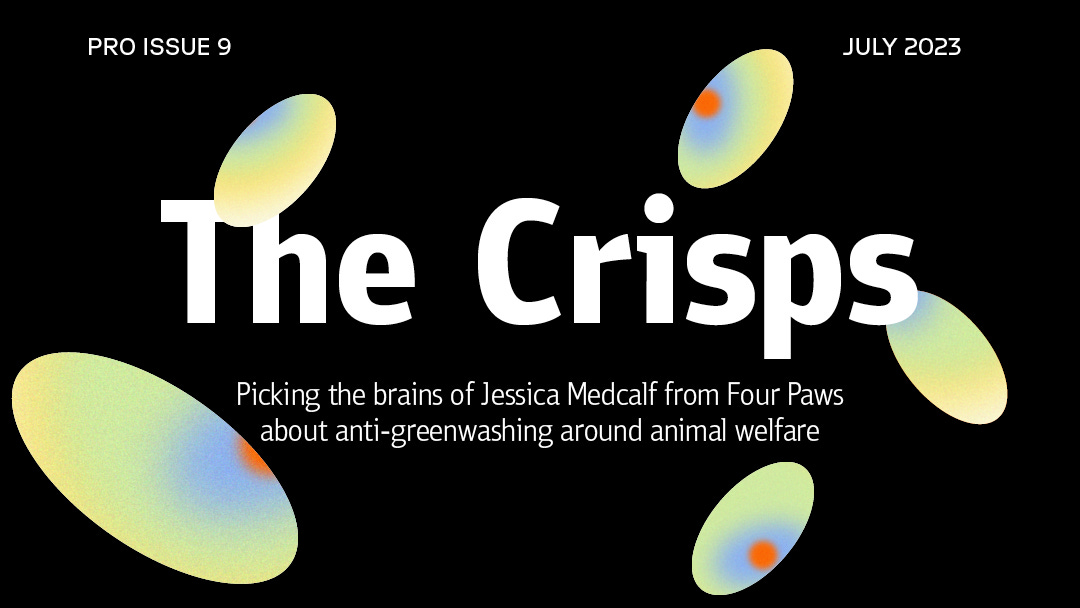Over FIVE billion animals are used for fashion each year
How to avoid greenwashing animal welfare with Jessica Medcalf of FOUR PAWS. Plus, key findings of their new reports "Taming Fashion".
Welcome to another pro issue of The Crisps – your newsletter on anti-greenwashing and honest fashion communication. After touching on the basics and terminology around animal welfare last week, we’re sharing the key findings of the new report series “Taming Fashion” by FOUR PAWS1. Plus, we talked to Jessica Medcalf, Animal Welfare in Textiles Programme Lead at FOUR PAWS, about greenwashing tactics fashion brands might use around animal welfare and what the most important steps for brands are to move towards animal welfare.
Don’t miss out on our bi-weekly deep dives and become a pro subscriber. You’ll get 20% off for 1 year with our Summer Special.
For far too long, animals have taken the back seat in sustainability discussions in fashion. While fur is banned by a lot of brands, the use of Animal-Derived Materials (ADMs) like leather and wool stays in fashion and gets hardly questioned by big brands.
Just to give you a little glimpse of the severity: In 2020, the hides and skins of over 1.4 billion animals were used for leather production alone.2 And the global animal welfare organization FOUR PAWS estimates that each year over five billion animals are used for fashion.3 While a large portion of fashion brands continue to use animal-derived materials, most fail to apply any measure to ensure their welfare. For example, just 2.66%4 of the world’s supply of wool and 4.1%5 of the world’s down and feathers are certified to an animal welfare standard.
So, we all can agree that this needs to change, right?! Last week, we already touched on the terminology as well as ethical aspects associated with animal welfare in our free issue “Breaking the silence on animal welfare”. In this issue, we summed up the key findings and calls to action from the new report series “Taming Fashion” published by FOUR PAWS last week. Plus, we talked to Jessica Medcalf, Animal Welfare in Textiles Programme Lead at FOUR PAWS, about the tactics brands will use to greenwash Animal-Derived Materials and what steps brands should take to ensure animal welfare along their supply chains.
“Taming Fashion” – what you need to know
In its new report series “Taming Fashion” the global animal welfare organization FOUR PAWS takes a stance on the use of Animal-Derived Materials (ADMs) in fashion and its environmental impact. Here’s what you should know and take away from it.
Key problems associated with ADMs:
🔸 Fueling the climate crisis: The window to halt catastrophic human-made climate change is rapidly closing. Action to reduce methane emissions is key to limiting global temperature rises to 1.5°C and helping to battle climate change. Livestock alone accounts for approximately 32% of human-caused methane emissions, animal agriculture contributes 14.5–16.5% of total global Greenhouse Gas Emissions (GHGs).
🔸 Processing with hazardous chemical products: ADMs are not as natural as they may seem. They require substantial processing and are generally washed, filled, or coated with harmful chemicals, containing heavy metals and on the basis of fossil fuels. Why? To ensure cleanliness and comfort during use, and to prevent them from biodegrading.
🔸 Animal suffering: We’ve mentioned it above, it is estimated that over 5 billion animals are used for industrialized textiles each year. Animal protection organizations have published countless records of animal abuse, in both certified and uncertified textile supply chains, highlighting the inherent risk to animal welfare within commercial systems. As a result, brands and consumers find it highly challenging to identify high-welfare supply chains with certainty.
🔸 Growth of industrialized husbandry: By fueling animal hair, skin and feather revenue streams, the fashion industry helps to provide the margins needed to sustain the growth of mass-industrialized animal agriculture.
Calls to action from the report series
FOUR PAWS have curated three essential calls to action which brands should implement and commit to:
Keep reading with a 7-day free trial
Subscribe to The Crisps to keep reading this post and get 7 days of free access to the full post archives.



